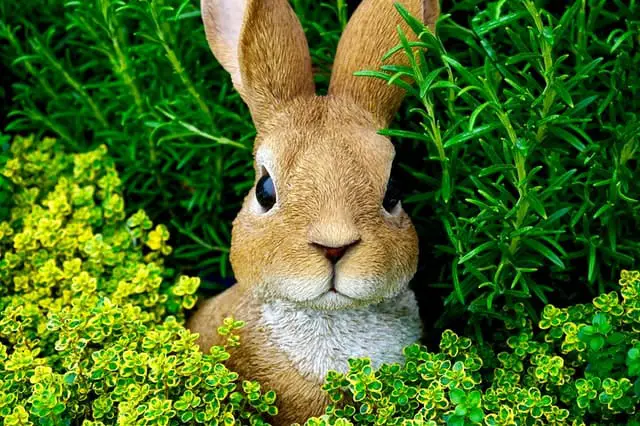The Dwarf Rabbit
What you should know before buying a dwarf rabbit

When it comes to the dwarf rabbit, most people immediately think of this charming, cuddly little animal with tender eyes and a quivering nose. But very few know anything other than its proverbial fertility, revered in many civilizations, but which, in our country, is considered a catastrophe and combated without mercy. We nibble it at Easter in the form of a chocolate bunny, we laugh at its cowardice, because we tend to confuse it with the hare.
Which dwarf rabbit will best suit your lifestyle?
All races of rabbits, pure or hybrid, lend themselves to domestication. But it must be said that a giant rabbit that exceeds 70 cm and 7 kg will have difficulty finding a place in a normal cage. Medium breeds are quite difficult to breed in apartments.
So here is our advice on this:
- The dwarf rabbit : with a lively character, it does not exceed 1.5 kg, and its round muzzle with cute little ears makes it a children’s favorite.
- Dwarf hybrids : a little bigger, but just as lively and funny, they are the ones most often found in pet stores. Small breeds: from 2.25 to 3.25 kg, there are more than 20 breeds, with extremely diverse characters.
- Angoras : The dwarf angora rabbit weighs 2.5 to 4.5 kg, they have a soft and calm character, which is suitable for children, they provide valuable wool but they must be carefully sheared every three months and keep very clean.
- The Havana rabbit : from 2.5 to 4 kg, it is also a long-haired breed, but it should not be sheared. It is enough to brush the coat regularly. Warning ! : Some people are allergic to rabbit hair. If in doubt, ask your doctor for advice.
Relationship of Dwarfs Rabbit with other domestic animals
You may already have other animals. This can create difficulties that you should consider before making any purchase.
The dwarf rabbit and the guinea pigs : The relationship is good and they can share the same cage, especially if they have grown up together.
The dwarf rabbit and the birds : If they hiss or cry, it is better to put the cage in another room.
The dwarf rabbit with cats and dogs : You will have to teach them how to behave with a rabbit. But the results are not guaranteed, especially in the case of an animal which, long alone, had until then focused all the attention. You risk fits of jealousy, or the awakening of a latent hunting instinct. I advise you to do the “ habituation and cohabitation test”.
If the antipathy is too strong, it is better to give up the rabbit or you will have to keep the two animals constantly separated. My experience has shown me that this is not a good solution, and that it is difficult to put into practice in an apartment with children.
What Male Female Combination of Dwarf rabbit can you get
All dwarf rabbits are sociable and like to live with their peers. If you want to please your pet rabbit, get a couple from the start. Especially if you have little time and are often outdoors. If you want to keep more than two rabbits, you will need a very large cage or a spacious hutch.
Two males can only support each other the first months. As soon as they reach sexual maturity, they will start to fight to establish their territories and they can get seriously injured. Two females get along quite well if they have grown up together .
The best would be if they were of the same scope. A couple will give you babies all the time – which is undesirable.
The best, especially if you want to buy a second animal later, is to take a neutered female or male.
Male or female ?
A female lends itself better to apartment breeding . Male rabbits must be neutered, otherwise they are very restless and urinate everywhere. Their urine has a sweetish, penetrating and persistent odor.
How to spot the sex : it is not very easy when the rabbit is young, it is better to ask the breeder or an animal specialist who knows about rabbits.
If the rabbit is older, we can tell if it is a male by light pressure on the stomach, which will spread the edges of the genital opening until the limb appears. Another unmistakable sign is the presence, on both sides of this orifice, of the testicles, which have not yet been formed in the child.
Dwarf rabbit or hybrid?
When they are young, all rabbits are small and cute. But only purebred dwarf rabbits will remain small and charming into adulthood. If they have been crossed, you never really know what it can be. Many gullible animal friends noticed after 8 or 9 months that their little dwarf rabbit had in fact become a baby rabbit and hadn’t been in its cage for a long time. The signs that will allow you to distinguish a purebred dwarf rabbit from a hybrid are visible from an early age, and it is best to buy your dwarf rabbit from a proven breeder.
A purebred dwarf rabbit is distinguished from a hybrid mainly by its significantly shorter ears, its rounder head directly resting on the cylindrical body and its short legs.
Can we give a Rabbit to a child?
We tend to easily and thoughtlessly offer animals to children. We forget that these are not disposable items. Today’s schoolboy who asks you for an animal will probably prefer the stadium or the disco in six or eight years. And the rabbit will remain alone and sad at the bottom of its cage, unless it has already been in a shelter for a long time, or has been abandoned. To avoid this, make it clear to your children what this purchase means.
Before any purchase
- Take a dwarf rabbit on trial , a classmate’s for example. Let your child take care of the rabbit, not just for fun, but also for all things of daily living.
- Do not give a rabbit to a child who is not yet of school age.
- Do not imagine that your child will be able to take responsibility for the animal alone . If you don’t want to deal with it, if you don’t enjoy it yourself, it is better to give up the purchase.
- Try to determine why your child suddenly wants a dwarf rabbit . Is it the fleeting urge to own a soft object to stroke? Unless your child feels too lonely?
From where can you buy a Rabbit?
In pet shops and animal departments of department stores, you can find mostly dwarf hybrids. If you want a purebred, dwarf or other rabbit, you will need to consult a specialist seller.
With the associations of rabbit breeders (yellow pages of the directory), there are sometimes purebred pups to sell.
Important advice before any purchase
What is the ideal age? Eight weeks is the best age to give a little dwarf rabbit . They start eating before the fourth week, but the intestinal flora is not adapted to solid food before the sixth week. This is a critical period, which is why serious breeders leave the young for another one to two weeks with their mother. Selling toddlers as young as four weeks old in stores is animal abuse. Health Condition: A healthy rabbit has a smooth, shiny coat. He is lively and cheerful, except when he is at rest. Depending on his temperament, he will take refuge timidly in a corner or he will come by curious little leaps to take part in what is happening.
Be careful: a sick dwarf rabbit remains indifferent in its corner, does not react to noise and stares in front of it with a murky eye. Other signs that should alert you:
- Flaming, watery eyes
- Frequent sneezing and coughing
- Runny nose
- A hard and swollen belly
- A spiky, lackluster coat, bald in places, and soiled with excrement in the belly or anus.
What to do with the Rabbit when you go on a vacation
With enough water, food, and grass, your rabbit can be left alone for one to two days in its cage.
If you are going away for a few weeks, you can:
- Take him if the car trip is short, if you are going to live in a temperate climate, and if you are staying in the same place where he can frolic (for example, in a country house). And here I am all clean and full of ardor!
- Have it looked after at home by a knowledgeable friend. He will need to ensure that the rabbit gets exercise, especially if it is alone. Let him not forget the daily caresses either.
- Have him stay away from the house: in a pet store, if he can go out once a day, and if he is not near noisy birds all the time.
6 peculiarities of toy or dwarf rabbits
Here are six facts so you know if you really want to house dwarf rabbits at home.
- Dwarf rabbits can be easily trained and have behavioral characteristics similar to those of dogs and cats . Training depends on the dedication of each owner, but if you put in a little time, you will be highly rewarded for your efforts!
- Despite being very small, this breed can take a lot of play and handling time to keep their brains active and release energy.
- Some dwarf rabbits can be nervous and develop a wild temperament . Avoid these unwanted behaviors with close attention and care from a very young age.
- The teeth too big and long is a common health problem. Help keep your rabbit’s teeth healthy by providing plenty of fiber as well as chew and gnaw toys that wear down the teeth.
- This breed can live happily indoors and outdoors, but it will need plenty of space and exercise wherever you decide to house your pet .
- The amount of food for a toy rabbit should never exceed 30 grams per kilo of weight per day .
What do you need to take care of a dwarf rabbit
They are docile animals and easy to maintain, so to take care of a dwarf rabbit, in addition to veterinary attention, food and affection, you will only need to take into account some important keys to guarantee their well-being :
- Cage . No, not just anyone! Make sure that the bars are not covered with plastic to prevent your pet from gnawing on them. Regarding size, yes, it does matter! If you are going to have just one, the ideal is a cage with a minimum size of 90x60x50 cm. But the bigger, the more space and the more comfortable it will feel. It is also important that you place it in a quiet place, away from drafts or in the sun.
- Power . Caring for a dwarf rabbit requires knowing that they have a delicate digestive system and a tendency to obesity, so you should pay close attention to their diet. 80% must be hay and the other 20% must be made up of special feed for rabbits, vegetables and fruits allowed.
- Hair . They should never be cut, but it is important to brush their hair at least once a week. That way you eliminate knots and prevent the rabbit from swallowing them while keeping their fur soft, shiny… and healthy!
- Hygiene . They are very clean animals, so you do not need or should bathe it. If it is very dirty you can wash it with water, although you should dry it very well, paying special attention to the folds of the belly and genitals. If you notice that his hair is bald, dandruff or is not shiny, go to a veterinarian (specialized in exotic animals) to evaluate if he suffers from any disease.
- To gnaw . The rabbit needs to gnaw often to wear down its teeth. It is best to provide pieces of untreated wood, cardboard or tree branches (they can be fruit trees, but never cedar, which is poisonous).






